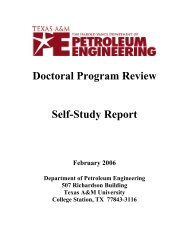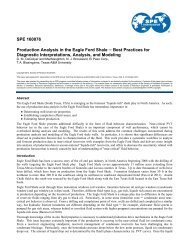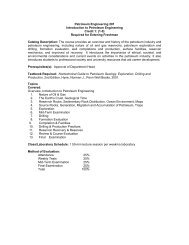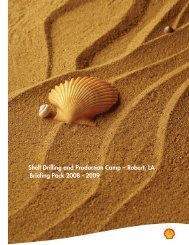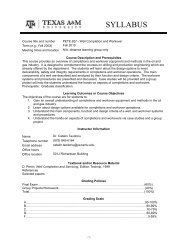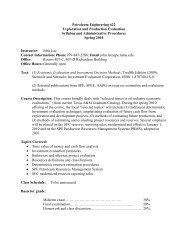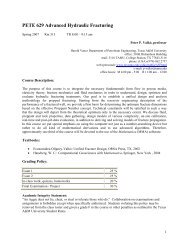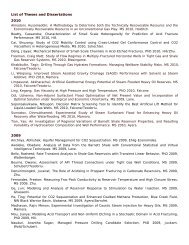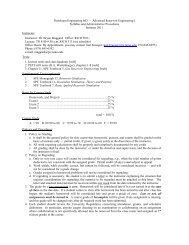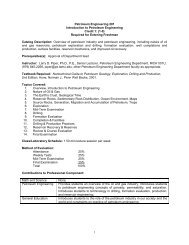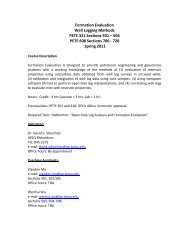Crisman Annual Report 2009 - Harold Vance Department of ...
Crisman Annual Report 2009 - Harold Vance Department of ...
Crisman Annual Report 2009 - Harold Vance Department of ...
You also want an ePaper? Increase the reach of your titles
YUMPU automatically turns print PDFs into web optimized ePapers that Google loves.
Acid Hydrolysis <strong>of</strong> Carboxybetaine Viscoelastic Surfactant<br />
Objectives<br />
Viscoelastic surfactants (VES) are recognized by<br />
their unique ability to form gel in-situ, and thus<br />
have been widely applied in acid diverting and<br />
fracturing treatments. Several types <strong>of</strong> VES have<br />
been used, including carboxybetaine surfactants.<br />
However, when mixed with hydrochloric acid under<br />
high temperatures, this particular type <strong>of</strong> VES is<br />
subjected to acid hydrolysis and may lose its viscoelastic<br />
property.<br />
The objective <strong>of</strong> this study is to examine the impact<br />
<strong>of</strong> acid hydrolysis <strong>of</strong> carboxybetaine surfactants on<br />
their performance in various field applications.<br />
Approach<br />
Hydrolysis experiments were conducted on HCl<br />
solutions that contained 7 wt% VES at various<br />
temperatures, acid concentrations and time. These<br />
fluids were heated to the temperature <strong>of</strong> interest,<br />
held for different periods <strong>of</strong> time, cooled to room<br />
temperature, neutralized by CaCO 3<br />
and their<br />
viscosity was measured as a function <strong>of</strong> shear rate<br />
using a Grace Instrument M3600 viscometer.<br />
Accomplishments<br />
It was found that these VES fluids lost viscosity<br />
significantly after hydrolysis, and the viscosity <strong>of</strong> the<br />
hydrolyzed sample was influenced by temperature,<br />
acid concentration, and time. Moreover, an oily<br />
phase was separated from the aqueous phase in the<br />
hydrolyzed samples.<br />
Significance<br />
The observations from the experiments indicated<br />
that when carboxybetaine VES is mixed with HCl at<br />
high temperature, it may lose its ability to increase<br />
fluid viscosity; and further more, the two phase<br />
mixture after hydrolysis may cause formation<br />
damage. Current research work will be conducted<br />
to investigate what factors affect acid hydrolysis <strong>of</strong><br />
carboxybetaine surfactants, and how they affect it.<br />
At the end <strong>of</strong> this research, recommendations will be<br />
given on how to use these surfactants in the field.<br />
CRISMAN INSTITUTE<br />
Project Information<br />
2.5.16 Quantitative Analysis <strong>of</strong> Amphoteric Surfactant<br />
Related Publications<br />
Yu, M. and Nasr-El-Din, H. Quantitative Analysis <strong>of</strong> an<br />
Amphoteric Surfactant in Acidizing Fluids and Coreflood<br />
Effluent. Paper SPE 121715 presented at the <strong>2009</strong> SPE<br />
Symposium on Oilfield Chemistry, Woodlands, Texas, 20-<br />
22 April.<br />
Contacts<br />
Hisham Nasr-El-Din<br />
979.862.1473<br />
hisham.nasreldin@pe.tamu.edu<br />
Meng Yu<br />
<strong>Crisman</strong> <strong>Annual</strong> <strong>Report</strong> <strong>2009</strong><br />
65



